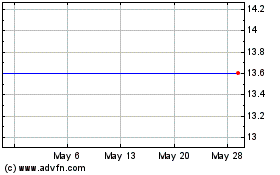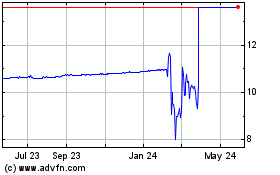For the First Time, Quantum-Enhanced Generative AI Generates Viable Cancer Drug Candidates
February 20 2024 - 7:00AM
Business Wire
The research demonstrates a breakthrough in
applying quantum-enhanced generative AI to drug discovery using
today’s quantum devices.
Zapata Computing, Inc. (“Zapata AI” or the “Company”), the
Industrial Generative AI company, today announced that its
scientists, in collaboration with Insilico Medicine, the University
of Toronto, and St. Jude Children’s Research Hospital have
demonstrated the first instance of a generative model running on
quantum hardware outperforming state-of-the-art classical models in
generating viable cancer drug candidates. The research points to a
promising future of hybrid quantum generative AI for drug discovery
using today’s quantum devices.
In the study, the researchers utilized generative AI to develop
novel KRAS inhibitors, a critical focus in cancer therapy
historically deemed “undruggable” due to its intrinsic biochemical
properties. Generative models running on classical hardware,
quantum hardware (specifically, a 16-qubit IBM device), and
simulated quantum hardware generated one million drug candidates
each, which were then filtered algorithmically and by humans. The
resulting 15 molecules were then synthesized and tested through
cell-based assays. The two molecules generated by the
quantum-enhanced generative model were distinct from existing KRAS
inhibitors and showed a superior binding affinity over the
molecules generated by purely classical models.
“This project is an exciting demonstration of how quantum and
classical computing can complement each other to deliver an
end-to-end solution,” said Yudong Cao, CTO and co-founder at Zapata
AI. “The collaboration between Zapata, UofT, St. Jude and Insilico
is also a great example of how the startup and university
ecosystems can leverage each other's advantages to drive progress.
We’re looking forward to taking this research further to move the
discovered molecules through the drug discovery pipeline, apply our
methodology to other disease targets, and extend our
quantum-enhanced generative AI to other industrial use cases with
complex design challenges.”
The research is currently published on ArXiv as it awaits peer
review. The study is a follow-up to a study published by the team
in 2023, in collaboration with Foxconn, that first showed the
promise of quantum generative AI for drug discovery.
“This research provides further validation of the potential of
Insilico’s generative AI engine, Chemistry42, to be combined with
quantum-augmented generative models in order to develop novel
therapeutic possibilities for difficult-to-drug targets in cancer
and other indications,” says Alex Zhavoronkov, PhD, founder and
co-CEO of Insilico Medicine. “This represents an important early
step toward a more advanced drug discovery future and we look
forward to working with Zapata AI and Alán Aspuru-Guzik at the
University of Toronto to further develop these methods."
The news also follows a recent announcement that Zapata AI has
entered a new strategic partnership with D-Wave Quantum Inc. (NYSE:
QBTS) (“D-Wave"), with an initial focus on building quantum
generative AI models that accelerate the discovery of new molecules
for commercial applications. “For the first time ever, we’ve been
able to produce real effective drug lead molecules with
quantum-enhanced generative AI,” said Christopher Savoie, CEO and
co-founder of Zapata AI. “The best part is this is only the
beginning. This is the same tech we are developing into a
commercial product in our work with D-Wave, which we expect to
bring to market quickly given the advanced commercial maturity of
Zapata’s generative AI technology and D-Wave’s annealing quantum
computing. We’re looking forward to expanding on this research to
discover new molecules for drug discovery and other industrial
applications.”
“I have always been excited about the potential of AI and
quantum computing for drug and materials discovery,” said Alán
Aspuru-Guzik, a professor of Chemistry and Computer Science at the
University of Toronto, as well as a co-founder and Scientific
Advisor of Zapata AI. “We are just starting to see how to integrate
quantum computing modules into the drug discovery pipeline. It is
great to see that we were able to successfully discover a new
compound to inhibit KRAS. Many questions are open. Although
everything you can do in this paper could also be done with a
classical computer, it is exciting to see that this work sets the
path for future, more powerful quantum computers to demonstrate
their abilities. The global community of researchers will be able
to further improve upon this first-of-a-kind experiment.”
The research leveraged the QML Suite Python Package available on
Zapata AI’s Orquestra® platform, which can be accessed here.
About Zapata AI
Zapata AI is an Industrial Generative AI company,
revolutionizing how enterprises solve complex problems with its
powerful suite of Generative AI software. By combining numerical
and text-based solutions, Zapata AI empowers industrial-scale
enterprises and government entities to leverage large language
models and numerical generative models better, faster, and more
efficiently delivering solutions to drive growth, savings and
unprecedented insight. With proprietary science and engineering
techniques and the Orquestra® platform, Zapata AI is accelerating
Generative AI’s impact in Industry. The Company was founded in 2017
and is headquartered in Boston, Massachusetts. On September 6,
2023, Zapata AI entered into a definitive business combination
agreement with Andretti Acquisition Corp. (NYSE: WNNR).
Forward-Looking Statements
Certain statements made herein are not historical facts but are
forward-looking statements for purposes of the safe harbor
provisions under The Private Securities Litigation Reform Act of
1995. Forward-looking statements generally are accompanied by words
such as “believe,” “may,” “will,” “intend,” “expect,” and similar
expressions that predict or indicate future events or trends or
that are not statements of historical matters. These
forward-looking statements include, but are not limited to,
statements regarding future events and other statements that are
not historical facts. These statements are based on the current
expectations of Zapata AI’s management and are not predictions of
actual performance. These forward-looking statements are provided
for illustrative purposes only and are not intended to serve as,
and must not be relied on, by any investor as a guarantee, an
assurance, a prediction, or a definitive statement of fact or
probability. These statements are subject to a number of risks and
uncertainties regarding Zapata AI’s business, and actual results
may differ materially.
If any of these risks materialize or if assumptions prove
incorrect, actual results could differ materially from the results
implied by these forward-looking statements. While Zapata AI may
elect to update these forward-looking statements at some point in
the future, Zapata AI specifically disclaims any obligation to do
so. These forward-looking statements should not be relied upon as
representing Zapata AI’s assessments as of any date subsequent to
the date of this communication. Accordingly, undue reliance should
not be placed upon the forward-looking statements.
View source
version on businesswire.com: https://www.businesswire.com/news/home/20240220020899/en/
Zapata AI Media: press@zapata.ai Investors:
investors@zapata.ai
Andretti Acquisition (NYSE:WNNR)
Historical Stock Chart
From Oct 2024 to Nov 2024

Andretti Acquisition (NYSE:WNNR)
Historical Stock Chart
From Nov 2023 to Nov 2024
